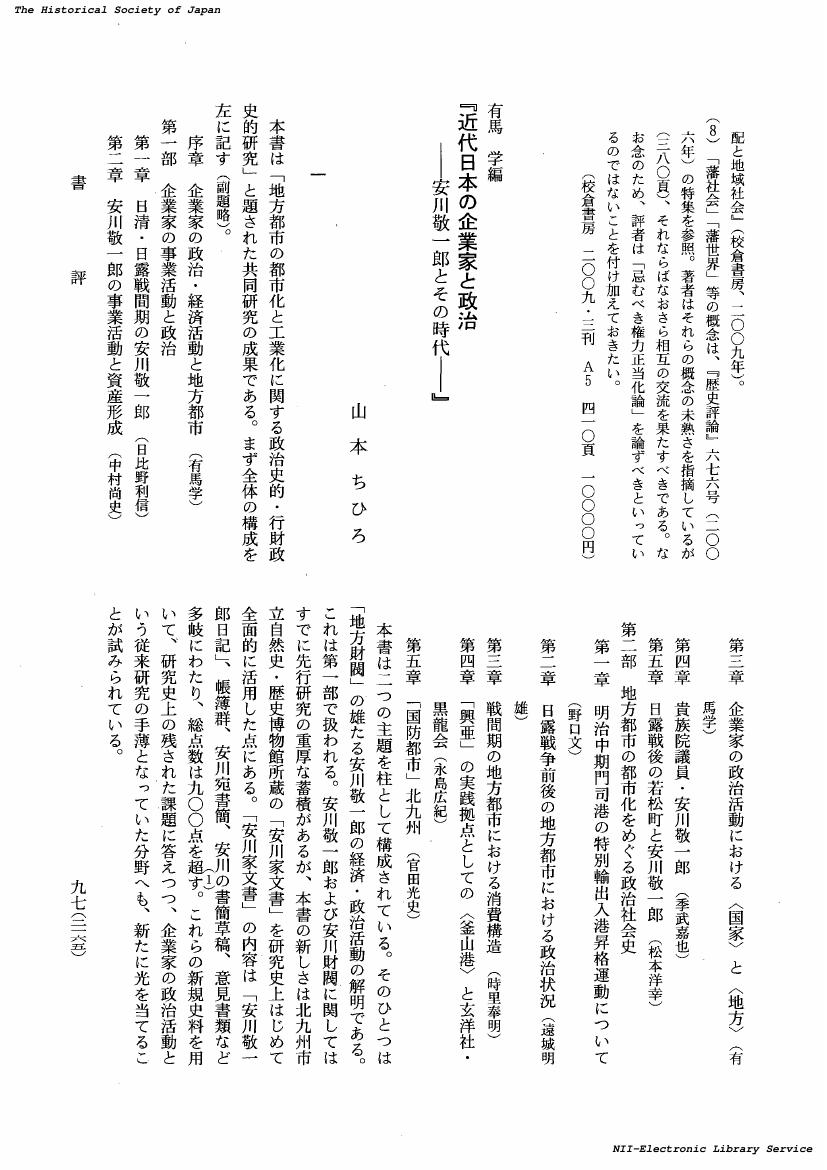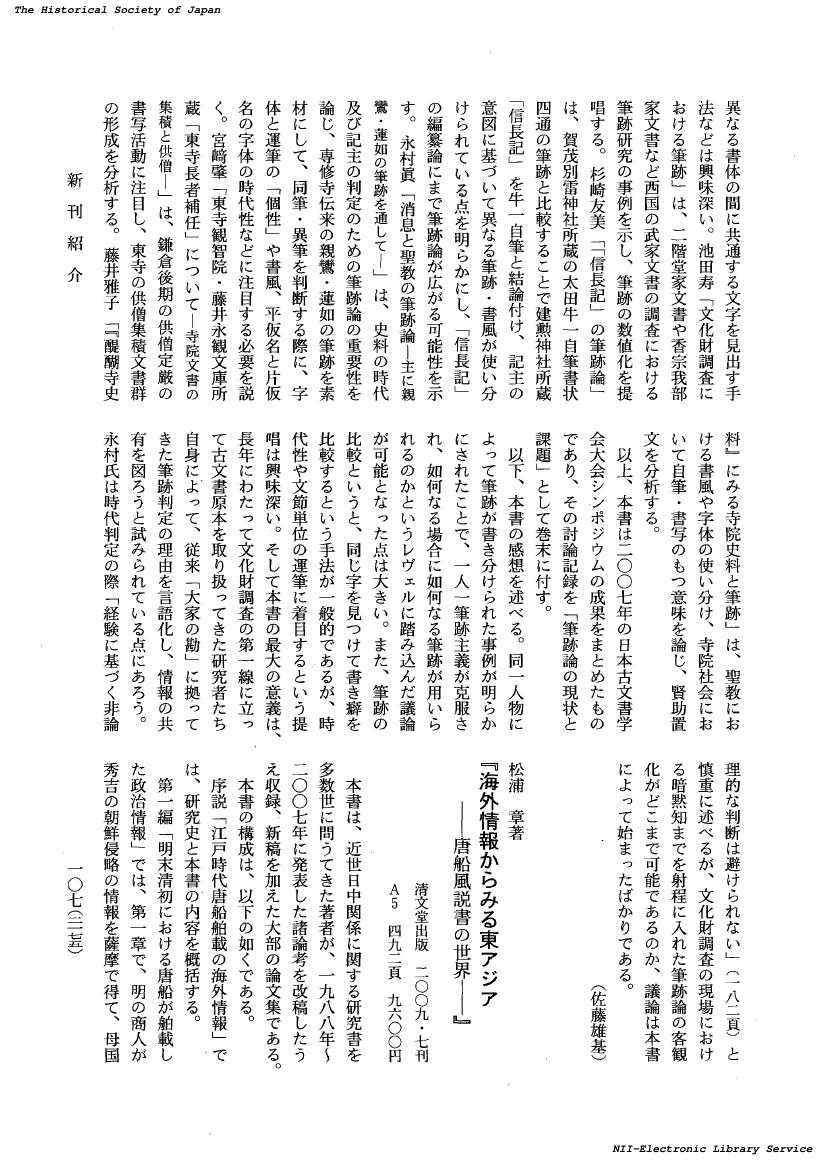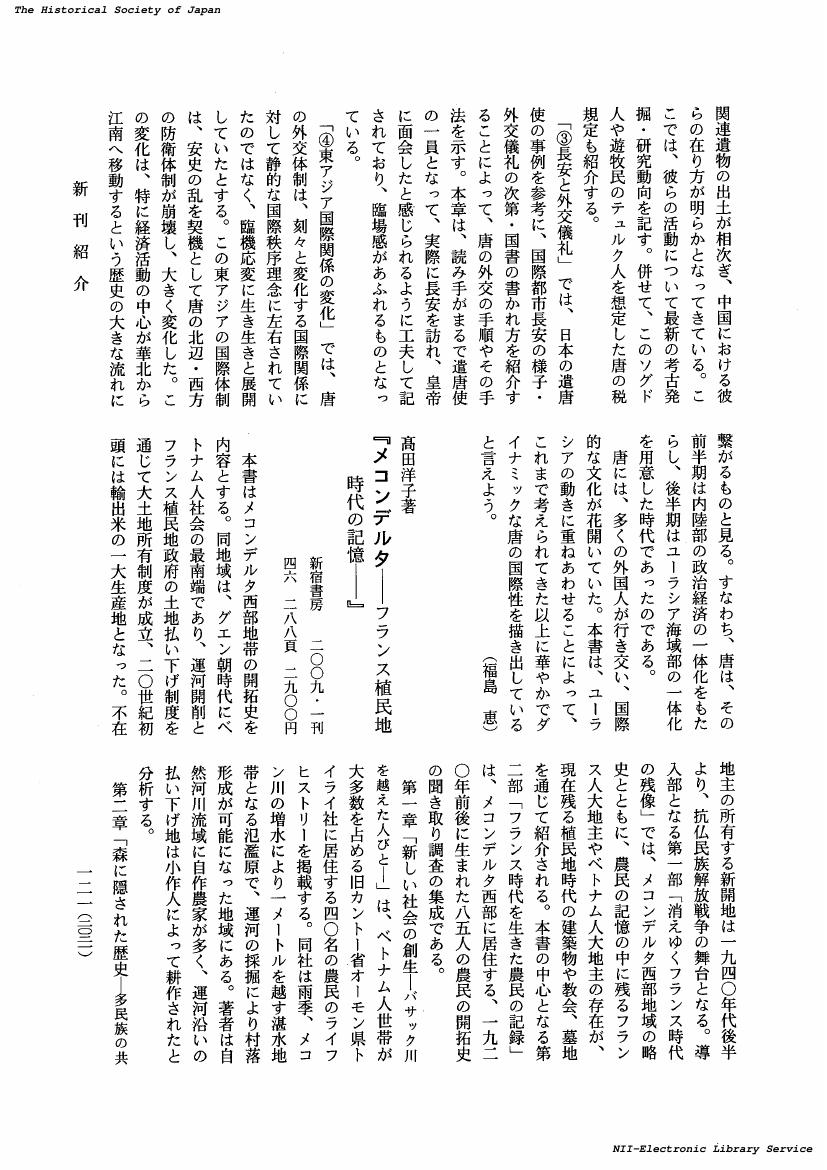- 著者
- 鍋谷 郁太郎
- 出版者
- 公益財団法人 史学会
- 雑誌
- 史学雑誌 (ISSN:00182478)
- 巻号頁・発行日
- vol.119, no.1, pp.121, 2010-01-20 (Released:2017-12-01)
- 著者
- 森田 直子
- 出版者
- 公益財団法人 史学会
- 雑誌
- 史学雑誌 (ISSN:00182478)
- 巻号頁・発行日
- vol.119, no.1, pp.120, 2010-01-20 (Released:2017-12-01)
- 著者
- 鈴木 楠緒子
- 出版者
- 公益財団法人 史学会
- 雑誌
- 史学雑誌 (ISSN:00182478)
- 巻号頁・発行日
- vol.118, no.1, pp.135, 2009-01-20 (Released:2017-12-01)
- 著者
- 山本 ちひろ
- 出版者
- 公益財団法人 史学会
- 雑誌
- 史学雑誌 (ISSN:00182478)
- 巻号頁・発行日
- vol.118, no.12, pp.2165-2173, 2009-12-20 (Released:2017-12-01)
- 著者
- 佐藤 雄基
- 出版者
- 公益財団法人 史学会
- 雑誌
- 史学雑誌 (ISSN:00182478)
- 巻号頁・発行日
- vol.118, no.12, pp.2174-2175, 2009-12-20 (Released:2017-12-01)
- 著者
- 松方 冬子
- 出版者
- 公益財団法人 史学会
- 雑誌
- 史学雑誌 (ISSN:00182478)
- 巻号頁・発行日
- vol.118, no.12, pp.2175-2177, 2009-12-20 (Released:2017-12-01)
- 著者
- 国分 航士
- 出版者
- 公益財団法人 史学会
- 雑誌
- 史学雑誌 (ISSN:00182478)
- 巻号頁・発行日
- vol.118, no.12, pp.2177-2178, 2009-12-20 (Released:2017-12-01)
- 著者
- 堀内 淳一
- 出版者
- 公益財団法人 史学会
- 雑誌
- 史学雑誌 (ISSN:00182478)
- 巻号頁・発行日
- vol.118, no.12, pp.2178-2179, 2009-12-20 (Released:2017-12-01)
- 著者
- 保坂 悠紀
- 出版者
- 公益財団法人 史学会
- 雑誌
- 史学雑誌 (ISSN:00182478)
- 巻号頁・発行日
- vol.118, no.12, pp.2179-2180, 2009-12-20 (Released:2017-12-01)
- 著者
- 五十嵐 大介
- 出版者
- 公益財団法人 史学会
- 雑誌
- 史学雑誌 (ISSN:00182478)
- 巻号頁・発行日
- vol.118, no.12, pp.2180-2181, 2009-12-20 (Released:2017-12-01)
- 著者
- 山本 大丙
- 出版者
- 公益財団法人 史学会
- 雑誌
- 史学雑誌 (ISSN:00182478)
- 巻号頁・発行日
- vol.118, no.12, pp.2181-2182, 2009-12-20 (Released:2017-12-01)
1 0 0 0 OA ピエール=イヴ・ボルペール著, 深沢克己編, 『「啓蒙の世紀」のフリーメイソン』, (YAMAKAWA LECTURES 005), 山川出版社, 二〇〇九・四刊, 四六, 一四七頁, 一五〇〇円
- 著者
- 田瀬 望
- 出版者
- 公益財団法人 史学会
- 雑誌
- 史学雑誌 (ISSN:00182478)
- 巻号頁・発行日
- vol.118, no.12, pp.2182-2183, 2009-12-20 (Released:2017-12-01)
- 著者
- 渋谷 由紀
- 出版者
- 公益財団法人 史学会
- 雑誌
- 史学雑誌 (ISSN:00182478)
- 巻号頁・発行日
- vol.118, no.11, pp.2021-2022, 2009-11-20 (Released:2017-12-01)
- 著者
- 澤田 萌
- 出版者
- 公益財団法人 史学会
- 雑誌
- 史学雑誌 (ISSN:00182478)
- 巻号頁・発行日
- vol.118, no.11, pp.2022-2023, 2009-11-20 (Released:2017-12-01)
- 著者
- 小林 祐門
- 出版者
- 公益財団法人 史学会
- 雑誌
- 史学雑誌 (ISSN:00182478)
- 巻号頁・発行日
- vol.118, no.11, pp.2023-2024, 2009-11-20 (Released:2017-12-01)
1 0 0 0 OA 一九世紀中葉廈門における苦力貿易の盛衰
- 著者
- 村上 衛
- 出版者
- 公益財団法人 史学会
- 雑誌
- 史学雑誌 (ISSN:00182478)
- 巻号頁・発行日
- vol.118, no.12, pp.2069-2105, 2009-12-20 (Released:2017-12-01)
This article reexamins the rise of coolie trade in mid-19^<th> century Amoy (Xiamen), the problems it generated and the role played by the British and Qing local officials in the process of solving those problems through a discussion of the social and economic conditions that China's coastal regions faced. The coolie trade in Amoy began as the formation of a network between Chinese and foreigners in the coastal regions met and intermingled with the traditional process of migration, becoming embroiled in the chaotic events that plagued these regions from middle of the century on. As a migrant labor demand-supply gap was created between expanding demand for low wage workers and growing unpopularity of the coolie trade, local Chinese brokers began resorting to such practices as abduction in order to secure good quality labor. However, due their indiscriminatory nature, these illegal practices were cited as draining the coastal regions of crucial human resources, forcing the powers that be to take measures for dealing with the coolie trade. The Amoy Riots that broke out in reaction to the coolie trade presented an opportunity for the British and Chinese authorities to cooperate in solving the problem, and this opportunity was made possible by a lack of any strong xenophobic sentiment in the region. Upon a request from the Qing local officials, the British Consulate took steps to drive out such Cantonese forces as large-scale coolie brokers and pirates, applying pressure on ships and merchants under both the British flag and those of other countries, resulting in the decline of the coolie trade. On the other hand, the emigration had already begun to concentrate in Southeast Asia under the blind eye of the local authorities, since this new source of labor posed no threat to regional security. Therefore, within the process of regulating the emigrant coolie trade, Qing local officials not only requested the British Consulate to take action against foreign merchants, but also commissioned the immigrant labor business. These tasks "commissioned" to Western countries and individuals, in particular the British, can be interpreted as a crackdown on smuggling and the pacification of piracy, both of which led to the reinstitution of Qing government control over its coastal regions. The introduction into China of modern institutions by the West that can be seen both as beneficial and coercive in nature was in fact implemented in the form of projects "commissioned" by China to Western governments, bureaucrats and private individuals.
1 0 0 0 OA 北朝・隋唐史料に見えるソグド姓の成立について
- 著者
- 斉藤 達也
- 出版者
- 公益財団法人 史学会
- 雑誌
- 史学雑誌 (ISSN:00182478)
- 巻号頁・発行日
- vol.118, no.12, pp.2106-2131, 2009-12-20 (Released:2017-12-01)
Under the Sui 隋 and Tang 唐 Dynasties, most of the Sogdian people living in China assumed one of the following nine surnames in accordance with the land or city of their origin: Kang 康, An 安, Cao 曹, He 何, Shi 史, Shi 石, Mu 穆, Bi 畢, and Mi 米. The place of origin of a family can actually be easily identified because of the regular correspondence between the surname and the toponym associated with the respective region. For instance, the surname 'Kang' 康 was given to those Sogdian families coming from the Land of Kang 康國, i.e. Samarkand. One finds only very few references to the history and reasons lying behind the diversification of the Sogdian surnames on Chinese soil. The present paper attempts to explore some of the basic aspects of this subject. Chapter One looks into the relation between Sogdian surnames and the names of their land of origin mainly by examining the linguistic facet of the problem. Chapter Two investigates relevant historical documents which allow us to trace the formation of each Sogdian surname. I examine the historical evidence for possible clues as to the background and reasons for choosing a certain surname. In both Chapters One and Two, I actually re-visit the most commonly accepted theory concerning the correspondence between Sogdian surnames and their place of origin, i.e. toponyms serving as surnames originate from rough phonetic transcriptions, or rather abridgements, in Chinese characters of actual Sogdian place names. These abbreviated toponyms were then given to the Sogdians depending on the region of origin. My investigation, however, reveals an opposite picture. Most of the Sogdian surnames were actually adopted for reasons not directly related to phonetic transcriptions. There is a consistent tendency of one group coming from a specific region to adopt one particular surname. Between ca. 560 and 600, we start seeing compounds as the 'Land of Shi' 史國 or 'Land of He' 何國. It is at this stage that the word 'land' 國 is used in conjunction with the surnames, and not the other way round. Chronologically speaking, in the early phase of Sogdian presence on Chinese soil, which starts with the Later Han 後漢 dynasty, Kang 康 was the only surname generally used for all members of this ethnic group regardless of their region of origin. Later, however, we witness a diversification. Probably as early as the latter half of the 5^<th> century, the surname An 安 may have also been used by people of Sogdian origin. Sometime between the end of the 5^<th> century and middle of the 6^<th> century, the Sogdians seem to have started adopting surnames like Cao 曹, He 何, Shi 史, and Mu 穆. Slightly later, three other names, i.e. Shi 石, Bi 畢, and Mi 米, also came to be employed. In Chapter Three, I try to explain the reasons and social background behind this diversification, and turn my attention to the relation between marriage customs and surnames. This chapter is based on a collation of relevant data extracted from funeral inscriptions between the 6^<th> century and 10^<th> century. My survey reveals the existence of a total of 83 cases in which at least one of the partners had one of the following surnames indicating Sogdian origin: Kang 康, An 安, and Mi 米. Amongst these, only three seem to have been couples in which both husband and wife bore the same surname. This fact suggests that for the most part, the marriage between Sogdian couples followed the Chinese custom of surname exogamy 同姓不婚. This fact leads me to believe that the diversification of the Sogdian surnames from one to nine served an obvious social function. This process made it possible for people coming from the same ethnic stock to get married while still respecting the Chinese taboo of surname exogamy. Actually, in 483 the Northern Wei dynasty 北魏 decreed that surname exogamy should be strictly observed. This might have been one of the(View PDF for the rest of the abstract.)
1 0 0 0 OA 一八世紀初頭フランスの商業会議所と商人社会 : ボルドーの事例を中心に
- 著者
- 君塚 弘恭
- 出版者
- 公益財団法人 史学会
- 雑誌
- 史学雑誌 (ISSN:00182478)
- 巻号頁・発行日
- vol.118, no.12, pp.2132-2156, 2009-12-20 (Released:2017-12-01)
The purpose of this article is to show the connection that existed between state organization and merchant society and describe the commercial strategy of elite merchants in early modern France, by focusing on the Chamber of Commerce of Guyenne, Bordeaux. The C of C was formed by a decision of the State Council in 1705. The French government at the end of the reign of Louis XIV allowed bourgeois merchants to participate in state political institutions, where they could engage in discussions concerning national and regional economic policy. According to one American historian, D. K. Smith, the activity of the C of C was an example of the new political culture of the time. The city of Bordeaux during this period was experiencing initial development through the colonial trade; and the city's merchants would at times need to negotiate with the government in order to achieve commercial success in their enterprises. This article investigates the questions of how the merchants of Bordeaux participated in the C of C and what function the institution performed within the city's merchant society. To begin with, the elite merchants of Bordeaux, who had been old members of the Tribunal of Commerce, were supportive of the C of C and decided to govern it by themselves until 1704. Then from 1705 on, they undertook to elect the directors of the Chamber from among their own and consequently monopolized the directorship throughout the eighteenth century. Although the C of C's directors were limited to the bourgeois merchants who were natives of Bordeaux, they maintained their links with both protestant and foreign merchants. Within this process, the elite merchants of Bordeaux took control of the C of C, as the, institution took root within the city's merchant society. Secondly, the Chamber of Commerce was the space not only where merchants could formulate and juxtapose their opinions against state policy, but also where merchants could acquire advice regarding their own problems. It is true that the directors were linked in a political network with the Council of Commerce of Paris, which they provided with commercial information; but when merchants in Bordeaux made inquiries about commercial affairs to the Chamber, the directors did discuss them and offered their expert opinions. Therefore, the Chamber was also an institution for promoting the activities of the bourse, forcing the researcher to reconsider this institution in the context of the long-term history of the bourse in the Western world. Finally, the Chamber of Commerce was the centre of commercial strategy in Bordeaux. Under state policy formulated to deal with the War of the Spanish Succession, the directors allowed the Dutch and ships of neutral countries entry into the port to purchase wine, while they, monopolized the colonial trade. As for regional commerce, the directors concentrated their attention to the route between Bordeaux and Agde of Languedoc, in addition to transportation along the Garonne and Dordogne Rivers. While considering the problems and the demands of the city's merchants, there is no doubt that the Chamber governed the merchant society of Bordeaux.
- 著者
- 平井 上総
- 出版者
- 公益財団法人 史学会
- 雑誌
- 史学雑誌 (ISSN:00182478)
- 巻号頁・発行日
- vol.118, no.12, pp.2157-2165, 2009-12-20 (Released:2017-12-01)
- 著者
- 本郷 恵子
- 出版者
- 公益財団法人 史学会
- 雑誌
- 史学雑誌 (ISSN:00182478)
- 巻号頁・発行日
- vol.118, no.11, pp.1989-1996, 2009-11-20 (Released:2017-12-01)
















